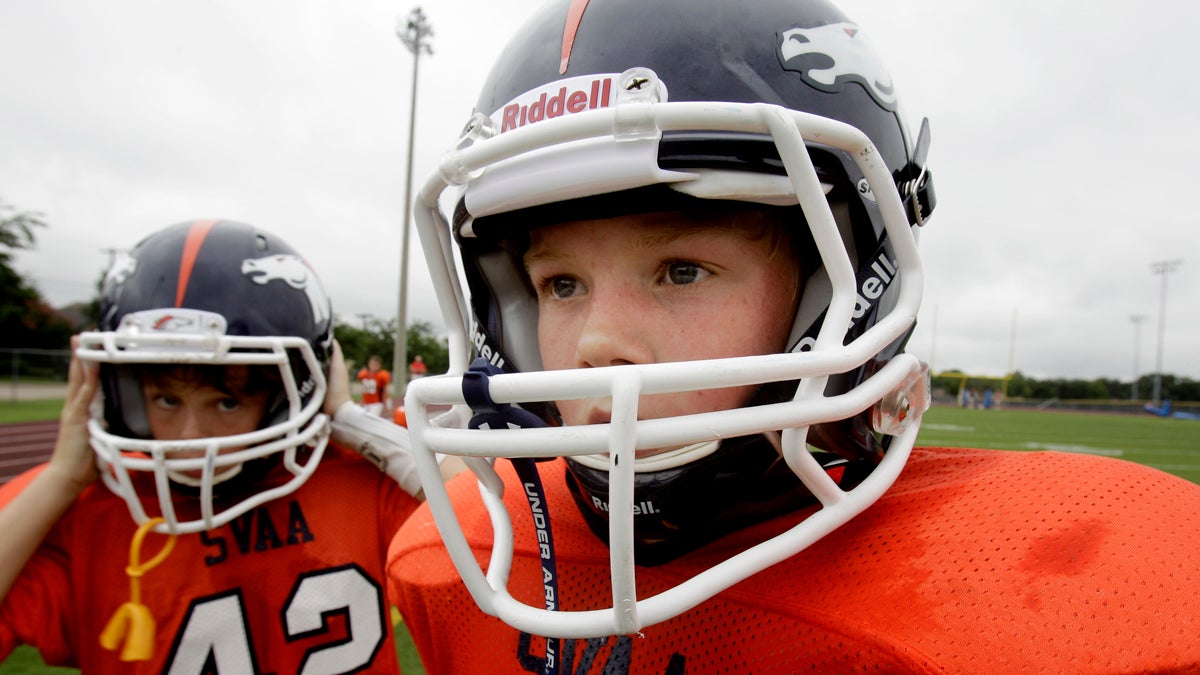Pro and con: Is football too dangerous for kids?
When you think of football, do you think about the concussions, crippling diseases or even the Alezimer's disease that your child can develop just from playing?

(AP Photo/LM Otero)
These two essays were written by students in Katherine Cohen’s 7th-grade English class at Greenberg Elementary in Northeast Philadelphia. The students were assigned the task of writing a persuasive letter. Some of those letters have been revised by the students and submitted to be published in various Philadelphia media outlets.
—
Paige Osborne: Football is too dangerous for children to play
What do you think of when you think of football? Children tackling each other, touch downs, or maybe even the NFL? Do you even think about the concussions, crippling diseases or even the Alezimer’s disease that your child can develop just from playing? Well these are consuquenses that are definitely part of football, and this brings up a serious question: Is football too dangerous for children to play? Football is too dangerous for children to play.
One reason football is too dangerous for children to play is because of chronic traumatic encephalopathy, otherwise known as CTE. It is a deadly brain disease that can develop from the repetitive hits and tackles young football players experience. Many parents start their children out at a very young age. However, because younger football players’ brains and bodies are not fully developed, they are more vulnerable to injuries, mainly to their brains. With more and more young people playing football, the risk of players becoming disabled is becoming greater and greater. Depression, behavior that is erratic, headaches, and Alzheimer’s disease (which does lead to death) are just some of the long-term effects of football. As a result, children should not play football due to its deadly effects.
Another reason is you are probably thinking, “My child is safe; they always have a helmet on when playing football.” Guess again, because no particular type of helmet can keep children 100 percent safe from injuries. It turns out when researchers tested different brands of helmets, they found virtually no difference in the safety of the headgear. Regarding the concussion rate, Xenith company brand helmets have over a 6 percent concussion rate, Riddell company has over a 9 percent concussion rate, and Schutt company headgear has over 8 percent concussion rate. You may not think these numbers are sufficient, but when you think of all the children that play football, the numbers really do add up. This is one of the many reasons why children should not play football. The helmets cannot always keep them safe.
The final reason why football is too dangerous for children to play is a concussion is one of the many risk factors of your child developing Alzheimer’s disease. A critical build up in protein in the brain, that has been linked to Alzheimer’s disease, has been proven to be five times more likely to occur in players that have had a concussion and memory loss. Drugs that have the potential to block the brain injury from turning into Alzheimer’s disease have not been created yet. Therefore, if your child played football and got a concussion which caused memory loss, they would be five times more likely for premature death.
Football is too dangerous. Players can develop CTE from just playing football, no safety gear can protect against this, and football or any sport can cause life-changing Alzheimer’s disease. In conclusion, these facts should be considered, and you should not sign your children up for football. It could mean the difference between your child living a handicapped life or a normal one.
—
Sources:
“Is football just too dangerous?” by Buzz Bissinger, New York Times Upfront Magazine
“Alzheimer’s risk tied to concussion in some” by Karen Weintraub, USA Today
“No sports-gear brand leads field in averting concussion” in L.A. Times.
Queena Wong: Football is not too dangerous
Do you think football is too dangerous? People around the world think football is too dangerous, while others say it is not. Football is not too dangerous.
More youth coaches than ever are taking education courses to keep football safe for the players in order for them not to get hurt. The coaches have been told to tell the players to use their shoulders instead of their heads. Coaches also have been taught how long to keep the players on the benches to let the players recover when they are injured. Coaches are using what they learned to keep the players safe. This reduces severe concussion rates.
No sport is risk free. The severe concussion rate for boy’s soccer is 12 percent. This is twice the severe concussion rate of boy’s football. Some say any sport or physical activity can cause a concussion. In conclusion, other sports have higher concussion rate than football.
Football is a safer game due to programs that are needed. USA Football, the official youth league for the NFL, are dedicated to providing coaches with the programs they need. These include certified coaching education, concussion awareness, USA Football Tackle Progression Model, and proper levels of contact at practice. Players also need proper-fitting equipment and heat preparedness, proper hydration, and nutrition.
In the end football is not too dangerous that it can not be played anymore. Coaches are teaching children to pay in a much safer way, no sport is risk free, and there are programs to help with the risk. That why football is not too dangerous. Let adults, teenagers, and children keep playing.
—
Sources:
“Is football just too dangerous?” by Scott Hallenbeck, New York Times Upfront Magazine
“Hoge, Hallenbeck join ‘Outside the Lines’ concussion discussion,” by Joe Frollo, USAfootball.com
“Will concussions kill football?” by Joseph Lapin, Pacific-Standard
WHYY is your source for fact-based, in-depth journalism and information. As a nonprofit organization, we rely on financial support from readers like you. Please give today.




